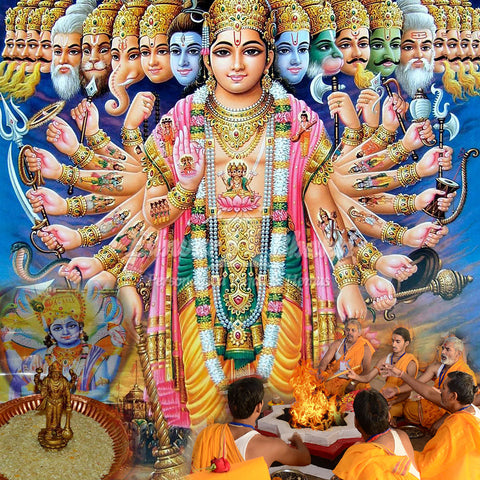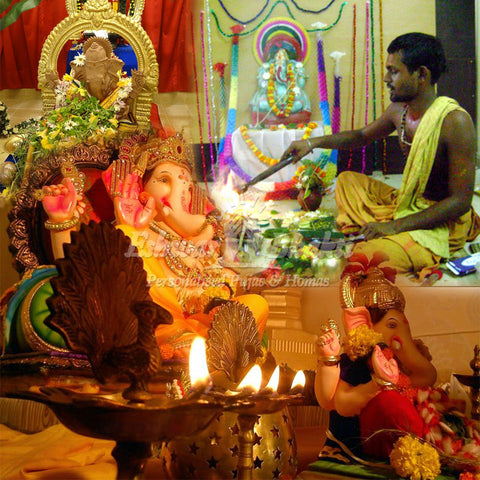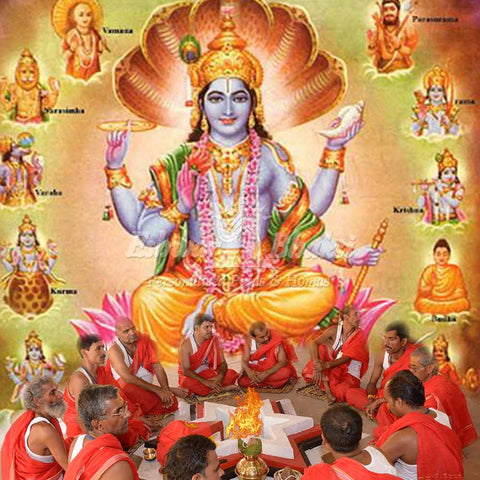Anant Chaturthi
 Hindu Festivals in India are being observed with rich tradition and culture even now. One of the important Hindu festivals in India is Anant Chaturdashi, related with Lord Vishnu and Ganesha. Like any other Hindu festival in India, Anant Chaturdashi is also a day with very high positive energies. Anant Chaturdashi falls on the last day of the ten-day-long Ganesh Chaturthi. This day is also famous as Ganesh Chaudas, a day when devotees bid adieu to Lord Ganesha by Visarjan (immersing idol in lake/sea) on the Anant Chaturdashi day. This auspicious day is also dedicated to Lord Vishnu who is worshipped in His Anant (infinite) form. Hindus observe Vrat (fasting) to get rid of karmic actions, sorrows and sufferings on this day. It is called as “Anant Vrat” meaning ‘endless’. Lord Vishnu’s reclining posture symbolizes the state of spiritual rest. It is also the actual form of Narayana before the evolution of the entire cosmos.
Hindu Festivals in India are being observed with rich tradition and culture even now. One of the important Hindu festivals in India is Anant Chaturdashi, related with Lord Vishnu and Ganesha. Like any other Hindu festival in India, Anant Chaturdashi is also a day with very high positive energies. Anant Chaturdashi falls on the last day of the ten-day-long Ganesh Chaturthi. This day is also famous as Ganesh Chaudas, a day when devotees bid adieu to Lord Ganesha by Visarjan (immersing idol in lake/sea) on the Anant Chaturdashi day. This auspicious day is also dedicated to Lord Vishnu who is worshipped in His Anant (infinite) form. Hindus observe Vrat (fasting) to get rid of karmic actions, sorrows and sufferings on this day. It is called as “Anant Vrat” meaning ‘endless’. Lord Vishnu’s reclining posture symbolizes the state of spiritual rest. It is also the actual form of Narayana before the evolution of the entire cosmos.
Significance of Anant Chaturthi: The auspicious day of Anant Chaturthi or Anant Chaudas falls on Chaturdashi or fourteenth day of the Shukla Paksha of Bhadrapada month. Shukla Paksha is the waxing moon phase.
Anant Chaturdashi reminds us to remain undisturbed by the changing phases of happiness and sorry in life. This is one of the key values prescribed by the scriptures to lead a harmonious and peaceful life. Lord Vishnu resting calmly on a bed of snake (Sheshnaga) is the symbolic expression of the tradition. It is a day to start practicing to remain balanced in both situations in life. Divinity within can be realised only by a someone who remains in tranquility in life. Here, Lord Ganesha represents the body consciousness of the individual that is considered as a temple for the omnipotent soul. The body conceived by any human being has to finally dissolve in the five elements one day, hence on this auspicious day of Anant Chaturdashi idols of Lord Ganesha is submerged in various water bodies like sea, pond, etc.
Ganesh Utsav/Chaturthi, which ends on the auspicious day of Anant Chaturdashi is the most important festival in the northern India. The grand celebration when idols of Ganapati Bappa, is worshipped by devotees for 10 days. These 10 days are full of devotion, performing puja and rituals by setting special pandals with Lord Ganesha's idol. Anant pooja is performed just before the Visarjan on this auspicious day. Though it is a farewell to Lord Ganesha, devotees praise and pray Him to come again next year.
Anant Chaturdashi is considered spiritually significant by the Jain community. The 12th Tirthankara – Lord Vasupujya, considered as head of the Jains, attained Nirvana on the day of Anant Chaudas. In the month of Bhadrapada, Paryushana is observed for 10 days, culminating with Anant Chaturdashi for the Digambara Jains. Basically, the Anant Chaturthi marks the end of Paryushana. There is a ritual of asking forgiveness for the mistakes committed by them in this life. It could be knowingly or unknowingly. It happens on the very next day after Anant Chaturthi and is called as Kshamavani.
Celebration of Anant Chaturdashi: Lord Vishnu is worshipped by devotees in northern states in the form of Kshirasagara, meaning the lord residing in the ocean of milk. Several prayers and offerings are performed to get blessings of Lord Vishnu. Devotees perform Anant Puja with high devotion and faith on the day of Anant Chathurthi. It is expressed by making 14 long ‘tilaks’ with traditional Kumkum powder. They also keep 14 puris (fried Indian bread) and 14 Malpuas (a deep-fried Indian sweet bread) on the 14 tilaks. This is followed by taking a bowl filled with the famous offering to lord called as Panchamrit (a mixture of curd, milk, jaggery, honey and ghee). It is kept on a wooden plank and is a symbol of divine ocean of milk, Kshirasagara. Sacred red thread (Mauli) with 14 knots is tied on a cucumber symbolizing Lord Anant. It is twirled 5 times by immersing in Panchamrit. It is a symbol of protection from negativity. Devotees then tie the read thread on their wrist. Men tie on their right wrist and women on the left wrist, for a period of 14 days. Fasting is also observed by devotees for wealth, good health and well-being. Fasting is called as Anant Vrat, continuously observed for 14 years.
 Legend of Anant Chaturdashi: The story is about a couple Sushila & Kayndinya. Sushila left her father’s house with her husband, Kaundinya, after being harassed by her stepmother. During the journey, they saw women worshipping Lord Anant. The rituals included offering of ghare & anarsa along with usual puja items. Devotees were tying silk threads on their wrists to invite the blessings of prosperity and well-being. Sushila too followed the ritual. When Kaundinya saw the string on her arm, she explained him the significance of tying the thread. He was not convinced about this and said this can happen only with intelligence and not with rituals. He then took off the string from her wrist and threw away. In a few days, their entire wealth was vanished and Kaundinya realised his mistake. As per the story, he went to the forest again searching the string. He asked everybody on way, even the animals, lakes and trees. He finally decided to hang himself in grief. A brahmin saw him and rescued and took to a cave. As they walked in, they reached a palace with several men and women assembled, presided by Lord Vishnu in the form of Ananta. He realised that it was Lord Vishnu himself in the form of a brahmin and confessed by falling on Lord’s feet. Lord Vishnu advised him to take 14 year vow to come out from sinful actions. This story conveys the importance of surrender to Lord.
Legend of Anant Chaturdashi: The story is about a couple Sushila & Kayndinya. Sushila left her father’s house with her husband, Kaundinya, after being harassed by her stepmother. During the journey, they saw women worshipping Lord Anant. The rituals included offering of ghare & anarsa along with usual puja items. Devotees were tying silk threads on their wrists to invite the blessings of prosperity and well-being. Sushila too followed the ritual. When Kaundinya saw the string on her arm, she explained him the significance of tying the thread. He was not convinced about this and said this can happen only with intelligence and not with rituals. He then took off the string from her wrist and threw away. In a few days, their entire wealth was vanished and Kaundinya realised his mistake. As per the story, he went to the forest again searching the string. He asked everybody on way, even the animals, lakes and trees. He finally decided to hang himself in grief. A brahmin saw him and rescued and took to a cave. As they walked in, they reached a palace with several men and women assembled, presided by Lord Vishnu in the form of Ananta. He realised that it was Lord Vishnu himself in the form of a brahmin and confessed by falling on Lord’s feet. Lord Vishnu advised him to take 14 year vow to come out from sinful actions. This story conveys the importance of surrender to Lord.
Summary: Lord Vishnu, worshipped as Lord Ananta, in His Yoga Nidra form is remembered on this day. Ananta Chathurthi, the famous Hindu festival in India reminds us to be peaceful and stable in all situations of life. It is similar to the sleeping posture of Lord Vishnu, though He is aware of everything going on in this Universe, but does not get affected.








